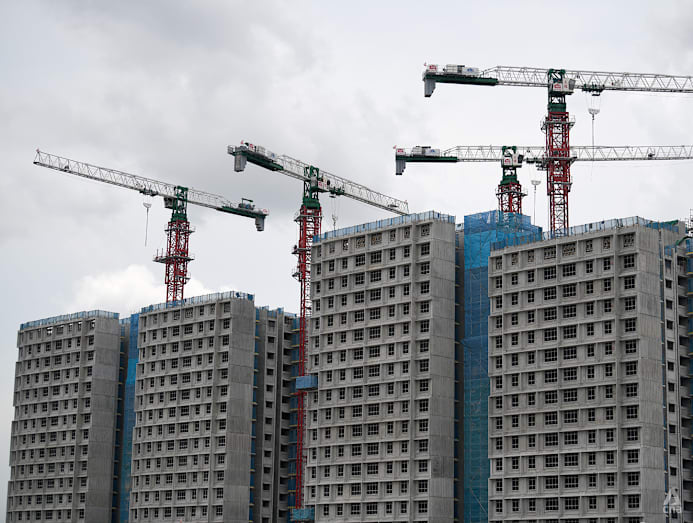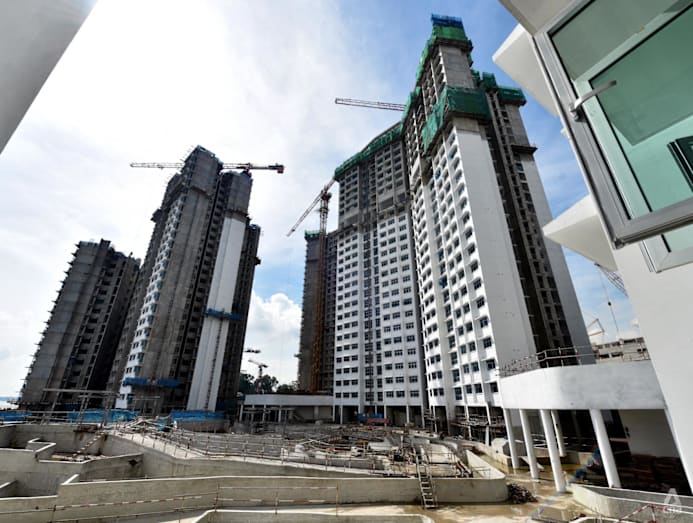How to choose your first home wisely under HDB's new Standard, Plus and Prime system
With the new classification of Build-to-Order flats, property experts and financial advisers say first-time buyers need to weigh not just location and price, but also long-term flexibility.

For young couples applying for Build-to-Order flats, it's crucial to decide what their priorities are and what they're willing to compromise on. (Illustration: CNA/Samuel Woo)

This audio is generated by an AI tool.
Adulthood is not just one phase of life but comes in stages. Its many facets can be overwhelming, from managing finances and buying a home to achieving work-life balance and maintaining healthy relationships. In this series, CNA TODAY's journalists help readers deal with the many challenges of being an adult and learn something themselves in the process.
This article is written in partnership with the Housing and Development Board.
When my husband and I started house-hunting in late 2023, we – like many other young couples – found ourselves caught in the tug-of-war between location and affordability.
We were looking for a resale flat, and I had dreamed of living somewhere in Ang Mo Kio, within walking distance of an MRT station and close to my in-laws. But looking at the prices in those areas – all about S$900,000 and above – we quickly realised we would have to compromise on some of our ideals for our dream home.
Shortly after, when it came time for some friends to apply for Build-to-Order (BTO) flats, I listened to them having the same conversations – what to prioritise and what to compromise on.
But they now faced one complication my husband and I had not: trying to make sense of the new housing framework.
Introduced last October, the Housing and Development Board (HDB) replaced the long-standing "mature" and "non-mature" estate labels with the new Standard, Plus and Prime system for new BTO projects – a change that came right as many of my own friends were applying.
Standard flats come with typical subsidies and a five-year minimum occupation period (MOP).
Plus and Prime flats, located in more desirable or central areas, have higher subsidies but stricter resale rules and longer 10-year MOPs to keep public housing fair and inclusive.
Many first-time buyers may see this new system as a complication.
Decisions appear to have become trickier as couples now have to consider not just price and location, but also new rules on resale, rental and how long they see themselves being tied to the flat.
I often see friends torn over the same dilemma: Is it worth stretching for a Prime flat in a central area, even if it means stricter rules later on? Or should they just go for something more affordable, a bit farther out, but with fewer strings attached?

The perfect answer doesn't exist, but after speaking to property experts and financial advisers, one thing's for sure – for BTO buyers, it's about finding a middle ground between what you want, what you can afford and critically assessing what would make the most sense for you in the next five to 10 years.
HOW TO BALANCE PRIORITIES
For many young couples, the first question is often this: "What should we prioritise? Location, price or flat size?"
"Location is the top priority for most buyers," said Mr Nicholas Cho, associate group director at PropNex Realty. "They might compromise on the size of the flat or stretch their budget a little, but once you've chosen a location, that decision is fixed."
Okay, sounds simple enough. But how do we decide on what a "good" location is for us?
Mr Cho often asks clients to anchor their choices around what matters most in their daily lives, such as proximity to parents, commuting distance, or ties to a familiar neighbourhood.
"Maybe they want somewhere near work," he said. "Or if they're planning for kids, it would be good to stay close to parents or be near schools."
But under the government's new Plus and Prime classifications for BTO flats, such units may now come with trade-offs.
Plus flats are located in more desirable areas, such as near MRT stations, amenities or the city fringe. Recent launches include projects in Queenstown, Bedok (Bayshore) and Kembangan.
Prime flats, on the other hand, are the most central and in-demand, typically within mature estates such as Kallang/Whampoa, Clementi and Toa Payoh.
Both types of flats come with with additional subsidies, a 10-year MOP and stricter resale rules.
Plus flats can be resold to only Singaporean singles or households (with at least one Singaporean), with a monthly income not exceeding S$14,000. Prime flats can be resold only to households (with at least one Singaporean) with a monthly income not exceeding S$14,000 or Singaporean singles with income not exceeding S$7,000.
While Standard flat owners are able to rent out their entire units, both Plus and Prime flats can't be rented out. Plus and Prime flat owners can only rent out bedrooms if their unit has three rooms or more - after meeting standard HDB rules.
When resold, a small portion of the flat's price is returned to HDB as a subsidy clawback to reflect the additional discounts given at the time of the original purchase, with a higher recovery percentage accorded to Prime flats to reflect the higher subsidies offered at the time of purchase.
Mr Joel Lim, associate head of research at 99.co, said the key trade-off for Prime flats is their premium location and lifestyle benefits, but at a much higher cost and with far less flexibility.
With a Plus or Prime unit, said PropNex's Mr Cho, the 10-year MOP and stricter resale conditions would likely make them significantly tougher to exit.
"If a young couple buys a Prime BTO, they should see it as both their first and possibly last home. By the time it's built and they serve the 10-year MOP, they'll be about 40."
At that stage, other financial factors come into play.
The older a buyer is, the shorter their loan tenure, said Mr Cho – which means higher monthly repayments. For instance, HDB loans are capped at 25 years, bank loans for HDB flats can go up to 30 years, executive condominium loans up to 30 years, and private property loans up to 35 years, with the maximum loan age capped at 65.
Beyond financing limits, mindset also plays a big role in how couples make their decisions.
In Mr Lim's experience, many first-time buyers tend to over-emphasise "wants" over "needs", often stretching their budgets for features that add little long-term value.
"Being near an MRT station or mall can be attractive, but these locations usually come with a heftier price tag and, in the case of Plus or Prime BTOs, stricter rules on resale and rental," he said.
Being near an MRT station or mall can be attractive, but these locations usually come with a heftier price tag and, in the case of Plus or Prime BTOs, stricter rules on resale and rental.
"A well-connected Standard flat a few MRT stops away can often provide 80 to 90 per cent of the same convenience at a much lower financial cost."
Other common wants, Mr Lim added, include a five-room flat when a four-room would suffice, or paying premiums for high floors and scenic views that may not significantly improve day-to-day living or resale value.
"Selecting a home with just enough space can free up funds for more meaningful goals like childcare, travel or savings, while keeping long-term flexibility intact," he said.
BUDGETING FOR REALITY
Once couples have weighed their priorities, the next step is facing the numbers.
Financial advisers said this is where many first-time buyers often get caught off guard, often because they make decisions based on aspiration rather than affordability.
Common missteps, they noted, include relying too heavily on housing grants without considering long-term affordability, and failing to plan for future expenses such as childcare, parental care or a partner's career break.
Mr Nelson Lee, senior director of sales at Thinkers Alliance, a branch representing Manulife Financial Advisers, recommended that a property's price should stay within five times a couple's annual household income.
So if a couple jointly earns S$15,000 a month, which is S$180,000 a year, then using that guideline, they should look at spending less than S$900,000 on a property.
Monthly mortgage payments should not exceed 25 per cent of gross income, he added.
However, Mr Lee cautioned that such rules of thumb aren't enough, as buyers should also look at their overall financial position, including the need for emergency funds, as well as savings to meet long-term goals.
"Keeping the cost of their housing low prevents them from becoming house-poor," he said. "It gives them flexibility to manage milestones like starting a family, buying a car or even upgrading their house in the future, without derailing their long-term goals."
Mr Tan Lye Poh, senior wealth director at Prudential Financial Advisers Singapore, similarly recommended keeping total housing expenses, including loan repayments, conservancy fees and home insurance, within 25 to 30 per cent of monthly household income, while setting aside buffers for interest-rate hikes or unexpected costs.
Both stressed that the real strain often comes after the purchase, when expenses such as stamp duties, legal fees and renovation works, which can total S$40,000 to S$80,000, start to add up.
They also said that couples should take time to assess how their housing decisions fit into their broader financial plans, maintain at least six months of emergency savings, and have open, realistic discussions about long-term goals – whether that's having children, changing jobs or supporting ageing parents.
"Communicate openly. Financial disagreements are a leading cause of conflict, so it's essential to align on affordability, goals and lifestyle expectations early on," said Mr Tan.

MAKING SENSE OF THE NEW FRAMEWORK
Overall, the new Standard, Plus and Prime framework is meant to help couples make more intentional housing decisions, experts said.
Dr Lee Nai Jia, head of real estate intelligence, data and software solutions at PropertyGuru Group, said that one year on, it is still early to assess the full impact of the tighter resale conditions for Plus and Prime flats.
Nevertheless, the aim is to reduce speculative gains while keeping public housing prices more grounded and affordable for the wider population.
"For couples, this means (Plus and Prime) flats may still carry a premium, but their price growth is likely to be more measured," he said. "Those who value future flexibility, such as upgrading later or moving more freely, may find Standard flats a better fit.
"Ultimately, the different flat types cater to different priorities, helping couples choose based on lifestyle needs rather than just market potential."
These rules may affect how much buyers can eventually sell their flats for, but what's more important is affordability at the start. For new BTO buyers, the only grant available is the Enhanced CPF Housing Grant (EHG), providing up to S$120,000 for first-time buyers, depending on income, which can help offset the cost of a new flat.
But as PropNex's Mr Cho pointed out, BTO projects are already subsidised, so the grants for them are relatively modest.
"A lot of couples are surprised when they realise that," he said. "The bulk of the generous grants actually go to resale buyers, because resale flats aren't subsidised."
Even so, experts have cautioned that grants should be viewed as a form of support, rather than a safety net for overreaching budgets.
At the end of the day, said Mr Lim, choosing a home is a deeply personal decision.
"Beyond crunching the numbers and weighing the pros and cons, it should reflect what the couple truly wants," he said.
"They'll be living there for at least five years and, for some, possibly a lifetime. The deciding factor should be what matters most to them, whether that's affordability, location or size."




.jpg?itok=eCp5s7-3)






